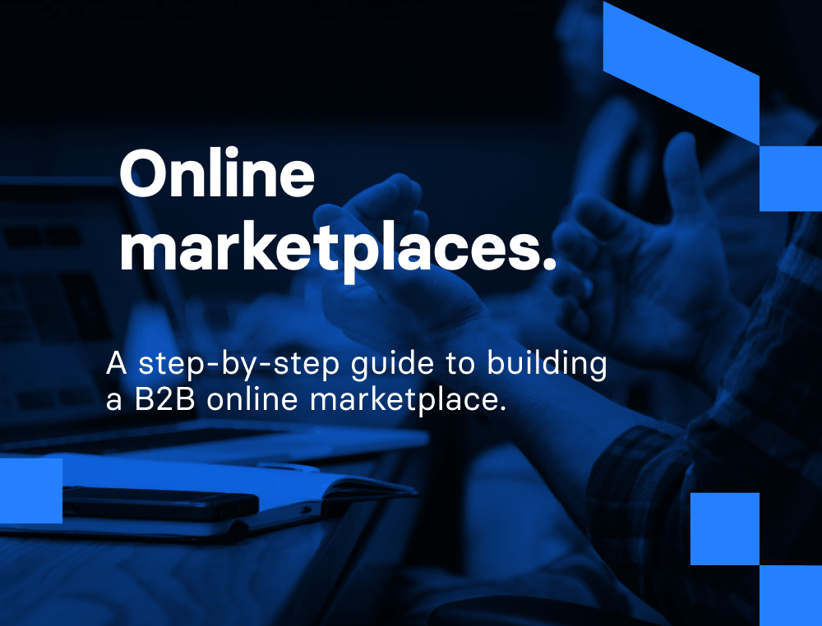- Building a B2B marketplace can be a two-year process. This may seem a long time but it is quite rapid for a fundamental change that will bring long-term profitability.
- Breaking the larger project into four separate steps makes it easier to achieve success.
- A radical change to business processes will meet some internal and external resistance from stakeholders, but educating people to the opportunities at hand will help get everyone on board.
The B2B marketplace is often an obvious opportunity for digital transformation of traditional business models. It creates a unified system that is used by producers, distributors, and end customers and makes processes easier at all stages. It is a huge value-add to even established business but building a B2B marketplace is a long-term commitment of time, money, and resources for the business and the project can require two years of budget if it is to be a total success.
It seems complex and perhaps even overwhelming, which may put people off. However, if you break it down into smaller actionable tasks, it is much easier to achieve. This article will show you how to take on a large B2B marketplace project in manageable phases in order to achieve success and truly transform your business.
B2B Marketplace | Phase 1
Discovery | 0 to 2 months
Background:
Like any IT project, it starts with understanding user needs and a thorough analysis of the industry. In B2B industries, one typical challenge is that distributors often work with legacy technology such as Excel sheets and make offers to clients in telephone calls, in face-to-face meetings, by email or even fax, or by sending PDFs. These methods are proven to work but have serious drawbacks. Distributors and stores both have no immediate access to current stock levels, dynamically changing prices or short-term special offers.
Workshops and interviews:
Reach out to distributors and stores to find out how the system works right now and what features they would use in an online platform. Do they want the current flow to be replicated 1:1 in an online version or are there some key elements that need to be the same but others that can be improved?
Challenges:
The stores that sell your products may be extremely different. When building a B2B marketplace for a national producer of alcoholic and non-alcoholic beverages, we had to bear in mind that some stores that sell the products are national chains with existing stock management systems and modern IT infrastructure, while other sellers are tiny one-man convenience stores with no computer system at all. Their reactions to a universal digital system will be very different.
Larger stores may also require multi-level accounts because front-line workers who can input orders into the system but don’t have authority to process them, as purchases need to be approved by a supervisor.
Don’t just survey one type of end customer or distributor; gain a wider understanding because the marketplace will need to serve everyone in the chain equally but also take special requirements into account.
Outcomes:
At the end of the discovery phase, you should have a list of features which need to be in the MVP, those which should be added in later iterations, and those which users suggested would not be useful. This last group is important as it stops you from getting over-ambitious. The marketplace should be simple, intuitive, and useful. Anything more creates a bloated system and also costs time and money. You can use the MoSCoW method at this phase of the project, listing technology and features as must have, should have, could have, and won’t have.
B2B Marketplace | Phase 2a
Prototype | 2nd to 4th month
Aim:
You should understand the main concept after Discovery but you will no doubt need to make changes and react to user feedback as the marketplace evolves. The best way to get this process started is to deliver a quick prototype and get people using it. Build a simple interface, get it up and running, and ask your sample target group which features work and which don’t.
Obstacles:
Remember that you are not asking people to convert from an existing system; you are encouraging them to sign up to an entirely new piece of technology that has minimal features and is far from perfect. Many people in B2B industries are not open to changing old habits anyway, so getting them to test a prototype can be tough. However, you need to find a way to get beta users signed up so you can hear their opinions, then make improvements to the first concept and deliver a great MVP for wider release.
Early adopter benefits:
Find the people from among your distributors and end customers who are tech-minded and show them the advantage of being beta users. Explain that they will have a better handle on the new platform than competitors and will, therefore, gain an advantage from being early adopters. You might also consider paying or rewarding people for being beta users.

B2B Marketplace | Phase 2b
Education | 2nd month onward
Positive PR:
You need to let everyone know that change is coming. As soon as Discovery is finished and you know that you are only a couple of months away from launching the skeleton version of the platform, you need to build awareness. This PR effort takes place parallel to the development process.
Changes and opportunities for sales:
The most resistance to a B2B marketplace often comes from intermediaries. Sales Representatives have won the trust of specific customers from whom they earn commission and make a steady living. In fact, the comfort of these relationships often stunts growth in a company as the status quo is comfortable and Sales Reps are not forced to look for additional clients. Reps are naturally adverse to these clients placing orders through a digital marketplace that cuts the Reps out of the established chain. It is important to educate your Sales Teams about how the future might look and clearly show how the marketplace can empower them and bring greater success than before as they will have opportunities and new revenue opportunities in the new way of working.
Activities:
Launch your first educational materials with the prototype, about two months before the wider launch of the official MVP.
1. Create a USP: Let end customers know that they can place orders at any time, not just when the Sales Team is in the office to take calls.
2. Create a video and other materials: Don’t just tell people about the system, show them how easy it is to use and what it can do.
3. Show the features: Explain what benefits each feature brings to end customers; for example, they can see the best offers from a number of suppliers on a single screen and save time and money when placing orders.
4. Create trust: Explain how a marketplace creates a more transparent network for everyone involved. Each buyer and distributor can see what others have to offer and prices are out in the open.
B2B Marketplace | Phase 3
MVP | 6th month to 2 years
Launch:
The Discovery phase lasts around two months. By the end of the fourth month, you should have a Prototype ready for beta users to test. After feedback and improvement, you should be ready for the general release of the MVP at the 6-month mark. Be realistic; don’t expect everyone to change behavior and convert to the system in the first few weeks. It has taken some businesses for whom we have built marketplaces up to two years to fully digitalize all internal salespeople and external end-users.
Retraining:
The aim for most B2B producers building a marketplace is not to replace the sales staff with technology. It is to reinvigorate and restructure the sales network. And, remember, not all sales will be digitized. The aim of the marketplace is generally an 80-20 split. You want all the small orders to go through the system, but large distributors or end customers who are placing massive orders will still want to speak to a sales agent about special discounts and to make sure that stock and delivery will not be an issue.
The Sales Reps who dealt with the 80% of orders that are being digitized will need to be retrained. Their job is no longer to serve the same people on a daily basis; it is to go out and find new customers and expand the reach of the product.
Budget and ROI:
A marketplace has the capability to completely transform hugely complex sales processes that have been in place for decades, and can actually start doing so within 6 months of conception and be fully formed within 2 years. Make sure to build in iterations so that only the most important features are in the MVP and budget is spread over time. The ROI is not always fast, as it is a fundamental change to the business which requires some considerable expense, but it will pay off in time and then continue to make more money for business.
B2B Marketplace | Phase 4
Calibration | 2 years onwards
Data:
Once your marketplace is complete and you have all the features installed and all stakeholders on board, you can leverage data analytics tools to see where there are bottlenecks, which features are performing best, and how you can evolve and improve the system. Technology moves fast and new capabilities are emerging all the time. Keep pace with the changes.
Revenue:
Your marketplace will cut the cost of infrastructure, travel, and technology, as well as saving time and effort at all touchpoints. However, you can also monetize the interface with:
- Paid advertisements placed by distributors on the platform to attract end customers to their specific offers
- Positioning of offers. With numerous distributors on the platform, paying for positioning helps offers stand out from the crowd
If you are looking to reinvigorate your business and unify your network of distributors and clients, a B2B marketplace is the fastest and best way to make a digital transformation. At Divante, we have experience building such platforms for national and international leaders in a range of industries. Speak to us about your plans and we’ll show you how to approach the process and unlock revenue faster through smart iterations.
We've compiled all of the articles from this series into one handy, downloadable resource which is augmented with additional statistics, expert opinions, and other great content. No matter your knowledge entry level, it's the ultimate guide to online marketplaces. Go to: A guide to online marketplaces and how to build one
Editorial team: Tim Clayton, Kaja Grzybowska
Technical advice: Tomasz Widlinski, Tomasz Basiura
Published June 22, 2020











